

Less Common Causes of Construction Site Accidents & Injuries. It’s no secret that working in construction is very tough.

Even under the best circumstances, the work can be very physically demanding, but things get even more difficult when you factor in all the different ways accidents can potentially occur on the job. In 2017, 259 construction workers were killed on the job and 21,760 suffered from non-fatal injuries while at work.
Some types of construction site accidents are more common than others. The Occupational Safety and Health Administration has their list of the “fatal four,” which are the four most common types of fatal construction site accidents. Construction Site Accidents Causes and Safety Tips to Prevent Them. Even the most diligent construction companies can still be at risk for a major accident.

Construction accidents don’t just happen on their own, either. It’s usually the result of a series of events that ultimately led to the incident. Common Construction Injury Types. Thank you for subscribing!
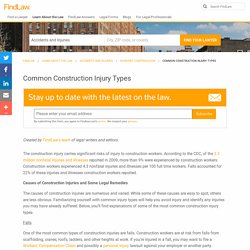
Created by FindLaw's team of legal writers and editors. The construction injury carries significant risks of injury to construction workers. According to the CDC, of the 3.3 million nonfatal injuries and illnesses reported in 2009, more than 9% were experienced by construction workers. Construction workers experienced 4.3 nonfatal injuries and illnesses per 100 full time workers. Falls accounted for 22% of these injuries and illnesses construction workers reported.
Causes of Construction Injuries and Some Legal Remedies. The Facts About Pedestrian Accidents. Every now and then, everybody needs to take a little bit of a walk to get from Point A to Point B.
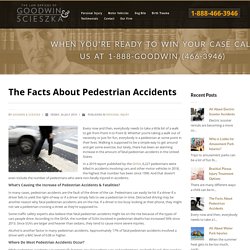
Whether you’re taking a walk out of necessity or just for fun, everybody is a pedestrian at some point in their lives. Walking is supposed to be a simple way to get around and get some exercise, but lately, there has been an alarming increase in the amount of fatal pedestrian accidents in the United States. In a 2019 report published by the GHSA, 6,227 pedestrians were killed in accidents involving cars and other motor vehicles in 2018, the highest that number has been since 1990. Pedestrian deaths could hit a 30-year high.
The number of pedestrians killed by automobiles is reaching a tragic milestone.
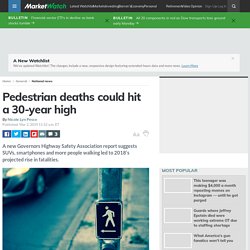
An estimated 6,227 people traveling on foot were killed last year, according to a new Governors Highway Safety Association report; an increase of 250 people from 2017, and the highest level since 1990. The figure is drawn from a statistical analysis of data collected from state highway safety offices for the first six months of 2018. The study projects that pedestrian deaths have climbed 51.5% since a low of 4,109 in 2009 to now comprise 16% of all road fatalities, which is up from 12% in 2009 — and the rising use of SUVs and smartphones could be to blame. Pedestrian Safety Tips. Springtime Slip and Fall Accidents. At long last, winter is over!
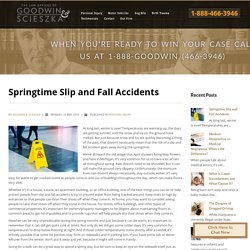
Temperatures are warming up, the days are getting sunnier, and the snow and ice on the ground have melted. But just because snow and ice are quickly becoming a thing of the past, that doesn’t necessarily mean that the risk of a slip and fall accident goes away during the springtime. 10 Ways to Prevent Slips, Trips, and Falls at Home. 7 Steps For After a Slip and Fall Accident. Safety at home: Falls. Homeowners Insurance Coverage & Slip and Fall Accidents. Anoxic and Traumatic Brain Injuries at Birth: What’s the Difference? Every year, far too many infants experience brain damage around the time of birth and those injuries can potentially have a significant impact on the child’s ability to grow and thrive.

But when we talk about brain injuries in newborns, it’s important to understand that brain injuries don’t all fall into one main category. Brain injuries are classified into different categories depending on factors such as how the injury was received and the type of force that caused the injury. Types of Traumatic Brain Injury. Traumatic brain injuries (TBI) are the most common variety of brain injuries, affecting as many as 1.7 million people and claiming 52,000 lives annually.
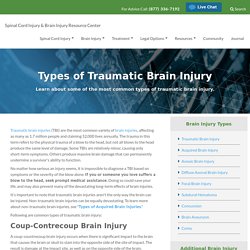
The trauma in this term refers to the physical trauma of a blow to the head, but not all blows to the head produce the same level of damage. Some TBIs are relatively minor, causing only short-term symptoms. Others produce massive brain damage that can permanently undermine a survivor's ability to function. No matter how serious an injury seems, it is impossible to diagnose a TBI based on symptoms or the severity of the blow alone. If you or someone you love suffers a blow to the head, seek prompt medical assistance. It's important to note that traumatic brain injuries aren't the only way the brain can be injured. Traumatic Brain Injury Resource Guide - Types of Brain Injury. There are two broad classifications of traumatic brain injury: open and closed.
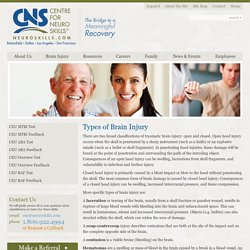
Open head injury occurs when the skull is penetrated by a sharp instrument (such as a knife) or an explosive missile (such as a bullet or shell fragments). Injured on the Job? Learn How SSDI and Workers’ Comp Impact Your Case. We all need to work to earn a living, but earning a living shouldn’t have to mean jeopardizing your personal health and safety.

Unfortunately, far too many people every year are injured on the job and not only do the victims have an injury to deal with, they also face losing income by taking time off from work to recover. Programs like workers’ compensation and social security disability (SSDI) can help people who have been injured on the job, but how do they impact your case? 8 Myths and Facts About Workers’ Compensation (August 2016) The LexisNexis Legal Newsroom Workers’ Compensation Law has interviewed leading experts from different segments of the workers’ compensation industry to tell us some common myths and facts about workers’ compensation. Note that the myths listed below are set forth in random order and not in order of importance, since the degree of “importance” depends on the reader and his or her stake in the workers’ compensation system.
Myth #1: Safety professionals have no value added role in the work comp claims process. Reality: Once a claim happens many organizations practice with the belief post claims works is all up to the in house claims contact and provider and claim services organizations. Some do not see any role for safety professionals in the claims management process. What part of the claim process should safety professionals focus on? Lori A. Myth #2: Workers’ compensation is an employee benefit that is essentially just like any discretionary employee benefit. Michael C. 10 weird facts about workers’ compensation. Michigan workers’ compensation law and weird facts about your benefits. We get frequent telephone calls from individuals outside of Michigan. They got hurt on-the-job and want to know their legal rights. Some of the questions make sense while others make you wonder. Unfortunately, each state has different workers’ compensation laws so we cannot provide much assistance.
10 Myths and Facts About Social Security Disability Insurance. If your health is so severely impaired that you cannot work, you may have considered applying for Social Security disability insurance (SSDI), a federal program designed to provide long-term financial protection for those who've paid into the program as working adults. If you've been reluctant to apply for SSDI because of horror stories about mountains of paperwork, denials, and long waiting periods for your first check, take heart: Many of these tales are simply myths. Avoid These Mistakes When Applying for Social Security Disability. It’s no secret that applying for social security disability insurance (SSDI) benefits is difficult. If you’ve ever applied and been denied, you’re definitely not alone — approximately 70% of all applications for social security disability benefits are denied the first time.
With so many different requirements to meet and rules to follow, it’s very easy to make mistakes. Here are just a few of the most common mistakes people make when applying for social security disability and how you can avoid them. Applying for Unemployment and Social Security Benefits Even though the Social Security Administration does not officially prohibit receiving unemployment benefits while receiving social security disability, it can send a mixed message about your ability to work. Trying to Apply or Appeal By Yourself. HOW TO APPLY FOR DISABILITY - WHAT MEDICAL CONDITIONS CAN YOU APPLY FOR? You may apply for Social Security disability for any medical condition (or conditions) that-- 1. Can be considered severe, 2. Prevents you from being able to engage in work activity that could be classified as substantially gainful, and 3. Regarding item three, this does not mean that you have to wait twelve months before filing a claim for social security disability or SSI disability since the limiting effects of your condition may be projected by social security.
In other words, if your physical or mental condition prevents you from being able to work, you should file a Social Security disability claim. Disability Benefits. Disability Planner: How You Apply For Disability Benefits. Infant Bruising, Bleeding, and Seizures Linked to Birth Trauma. Bruises in Infants and Toddlers. Objectives To determine the frequency and location of bruises in normal infants and toddlers, and to determine the relationship of age and developmental stage to bruising. Design Cross-sectional survey. Setting Community primary care pediatric offices. Subjects Children younger than 36 months attending well-child care visits. Bruising in a Newborn. BabyCenter. My baby has several bruises. Same Old, Same Old: RSI Prevention Tips.
When you hear about accidents and injuries in the workplace, you might immediately imagine them happening in traditionally dangerous work environments like factories, shipyards, or construction sites. 14 Repetitive Strain Injury (RSI) Prevention TipsMyBodyZone. 23 Oct Most people do nearly all their work on a computer these days, but life with a keyboard can be dangerous to your health. According to Microsoft, RSI costs UK businesses around £300 million a year in lost productivity, and the European Trade Union Federation estimates that the condition affects nearly a third of workers in the EU, a figure that to me seems a little high.
Published peer-reviewed studies put the overall incidence in the population at between five and ten percent, but for certain professions this can rise as high as 40 percent. Stretching exercises - Repetitive Strain Injury (RSI) Due to our daily work our muscles shorten and become stiff. With stretching we can reduce muscle tension and maintain or restore the original range of motion. 10 Simple RSI Prevention Tips. Repetitive Strain Injury (RSI) is a potentially disabling illness caused by prolonged repetitive hand movements, such as those involved in computer use. Symptoms include intermittent shooting pains in the hands, wrists, forearms, and back. Here are ten simple tips which may help you prevent computer-related RSI. The Summertime Black & Blues: 5 Common Summer Childhood Injuries. National Program for Playground Safety.
CDC - Playground Injuries. Swimming Pool Accidents: Public Pools & Your Rights. Swimming Pool Safety. 5 Ways To Make Your Swimming Pool Safer. Home Swimming Pool Safety Tips. How Common are Injuries for Baseball Fans? Baseball Injury Prevention & Treatment. Beat Summertime Injuries › Sports Medicine at UConn Health. 9 Sneaky Summer Injuries.